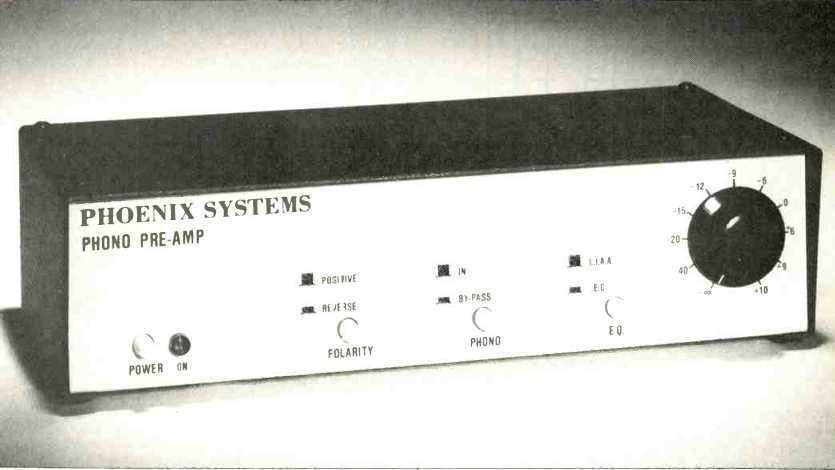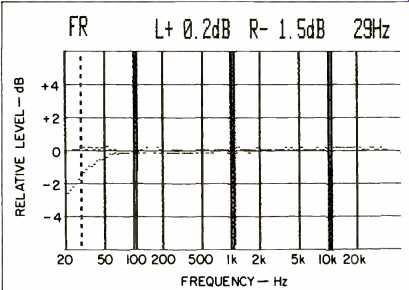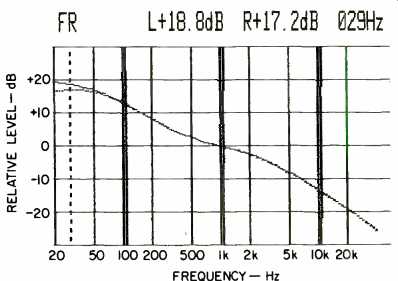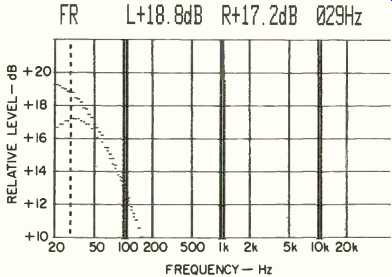
Manufacturer's Specifications:
Frequency Response: Phono, RIAA or IEC ± 0.25 dB; high level, -3 dB at 16 Hz, 0 dB at 100 kHz.
Phono Input Sensitivity: 1.5 to 10 mV at 1 kHz.
Phono Input Impedance: 47 kilohms, 100 pF.
S/N Ratio: 85 dB, IHF A-weighted.
THD: Less than 0.01%.
Phono Input Overload: 150 mV at 1 kHz.
Output Clipping: 8 V rms into 2 kilohms.
Slew Rate: High level, ± 13 V/uS; phono, ±2 V/uS (EQ-limited).
Dimensions: 11 1/4 in, (28.6 cm) W x 5 1/2 in. (14 cm) D x 3 in. (7.6 cm) H.
Price: Assembled, $200.00; kit, $150.00; optional variable input load (P-10-1L), $15.00.
Company Address: 91 Elm St., Manchester, Conn. 06040.
I always have a great deal of admiration for any small company that attempts to compete with the giants of the audio industry and comes out with a product that is competitively priced and performs well. This is probably because I found myself in exactly that position some 20 years ago, when both the audio industry and I were a lot younger. It was tough for a newcomer then; it's even tougher now.
John Roberts, President of Phoenix Systems, has developed a little preamplifier offered in several forms. Basically, the P-10 is a kit, with a rather amateurishly written set of assembly and wiring instructions. The version tested was supplied fully assembled, however, so I can't comment too meaningfully on the ease of assembly or, for that matter, the accuracy of the assembly instructions. (John Roberts says he put together my unit in 3 1/2 hours and estimates that a novice might do it in from 6 to 7 hours.) Since the instructions were obviously composed on a word-processing computer (as I could tell by the dot-matrix printing), they've probably been checked and double-checked. (Computers and word processors never make mista&#@c, RIGHT?) The P-10 I tested was designed for use with a moving-magnet or moving-iron cartridge, and is accordingly designated P-10-MM. An alternate version, the P-10-MC, can be had for use with-you guessed it-moving-coil pickups. The tested sample also incorporated an optional Input Load (P 10-IL) which involves a switch, found inside the preamp, that allows switching in up to 475 pF of capacitance in 25 pF increments.
The preamp is mounted in a brown metal wrap, and its beige front panel has only one rotary control knob which is coupled to a mechanically detented master volume control.
Calibration is in dB, from + 10 through-40, to "infinite." The 0 dB setting corresponds approximately to unity gain for the high-level AUX inputs of the preamp. Four small, white pushbutton switches handle power on/off, phono/high level selection, RIAA/IEC equalization selection, and selection of output-signal polarity. A red LED near the power switch illuminates when the unit is turned on.
The rear panel has pairs of phono, high-level and output jacks plus a chassis ground terminal. A small hole provides access to an internal, channel-balance trim pot, which affects only the phono input. Phoenix may feel that once you've adjusted your system's channel balance, there's no need to readjust it (which is true if you always sit in the same spot when listening) and that your power amp will have input controls so you can balance for off-center listening (which is usually true). If those assumptions apply to you, I suppose there's some justification to this simplification of the control panel, especially for the purists among us.
Circuit Highlights
The Phoenix P-10-MM employs two matched pairs of pF5103 J-FETs as the input stages for the phono section. A split-pole playback EQ network provides either standard RIAA playback IEC version (which incorporates a gentle roll-off at the low end), using a 7,950-4 high-pass single-pole network. The circuit also includes a 2-pole high-pass filter with a cutoff at 10 Hz for roll-off of warp and infrasonic signals.
Measurements
As received, the input sensitivity of the phono stages was 2.8 mV for 0.5-V output. This sensitivity is adjustable over a wide range, however. Signal-to-noise ratio for the phono inputs measured 83 dB, referred to a 5-mV input with the volume control adjusted to produce 0.5-V output. The S/N measurement was made using an A-weighting curve.
Signal-to-noise ratio via the high-level input measured 91 dB referenced to 0.5-V input, with the volume control set for unity gain. Phono overload at 1 kHz measured a more than adequate 215 mV.
Figure 1 is a plot of frequency response for the phono inputs. To obtain a "flat" curve, the applied signal had a very accurate (to within 0.1 dB) inverse RIAA response.
Note that vertical sensitivity of the display has been deliberately increased to 2 dB per vertical division, so as to show up any small deviations from true RIAA response. For the "R" plot, the RIAA/IEC switch was in the IEC position, and, as you can see, there is a deliberate roll-off of -1.5 dB at 29 Hz. The "L" plot employed the RIAA setting, and response was almost absolutely flat at 29 Hz (0.2 dB deviation noted above the diagram for that frequency).
The more usual RIAA response curve is plotted in Fig. 2. Here we see the typical bass boost and treble cut curves associated with RIAA equalization. The action of the IEC equalization setting on the preamp is depicted in the lower of the two curves seen at the left end (bass) of the diagram.
Again, the difference between the two curves is close to what we saw earlier in Fig. 1: + 18.8, + 17.2 or a difference of 1.6 dB. The 0.1 dB difference is attributable to measurement equipment tolerances.

Fig. 1--Normalized phono playback response. Upper curve is RIAA, lower
is response of IEC equalization to RIAA test signal. Note that vertical
scale is 2 dB/div.

Fig. 2--Response curves of phono preamp to constant-amplitude signals.
Upper curve is RIAA, lower is IEC.

Fig. 3--"Magnified" (2 dB/div.) display of phono-EQ bass boost.
Upper curve is RIAA lower is IEC.
To more clearly depict the difference between the low-end EQ curves of RIAA and IEC, I "magnified" the extreme bass end of Fig. 2 and displayed the results in Fig. 3. Here, vertical sensitivity is 2 dB per division instead of the 10 dB per division used in Fig. 2.
Use and Listening Tests
If you subscribe to the notion that simpler is better, you will like the Phoenix Systems P-10-MM. The power supply within this unit has been well positioned and well shielded to provide hum-free operation of the sensitive phono stages. I connected the P-10 directly to my reference power amp and played a wide variety of LP discs using the RIAA and IEC playback settings. The cartridge was a Shure V-15 Type V which behaved very nicely looking into a total of 250 pF, as selected using the internal load switch. I know that some people claim to hear a difference when signal polarity is reversed on a preamp, but I must confess that I heard none.
Music sounded equally good to me regardless of the setting of the polarity switch. This was not the case with the IEC/ RIAA switch. I am convinced that the RIAA's reluctance to go along with the IEC, an internationally recognized standards-writing body, is a mistake. The RIAA continues to live in a world in which everything is "perfect," whereas we all know that records go have warpage and turntables do have rumble. I'm all for an IEC low-end response in phono play back EQ, and Phoenix Systems was wise to incorporate this feature in their low-cost preamp. You can hear the difference, even on good turntables and even with records that are only slightly warped.
Obviously, the designers of this preamp could have gone a lot further if they wanted to cater to the super-fidelity purists. We might have seen gold-plated phono terminals, a power supply external to the body of the preamp itself, etc., etc., etc. It seems to me that what Phoenix has tried to do and has for the most part succeeded in doing-is to offer a simple, no-frills, good-sounding preamp that is easy to build and is low enough in cost to be affordable by just about anyone.
The unit is, in fact, so low priced that if you are unhappy with the phono section of your present preamp, you might even consider adding this unit for phono only, without discarding your more elaborate control unit. You could hook up your cartridge to the P-10-MM (or MC for that matter) and have its outputs go to the AUX inputs on your present preamp. If that displaces whatever was originally going to the AUX inputs on your existing preamp, the P-10's extra high-level inputs will take care of that situation as well.
-Leonard Feldman
(Source: Audio magazine, May 1983)
Also see:
New Tests for Preamplifiers (by Tomlinson Holman) (Feb. 1977)
Birth of a Spec? PHONO CARTRIDGE NOISE (March 1977)
= = = =